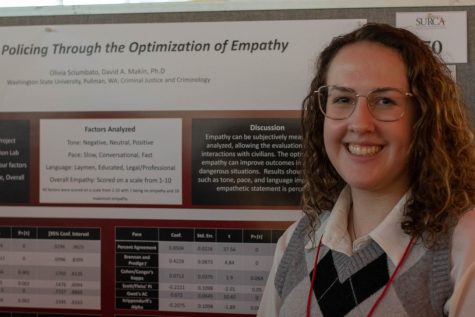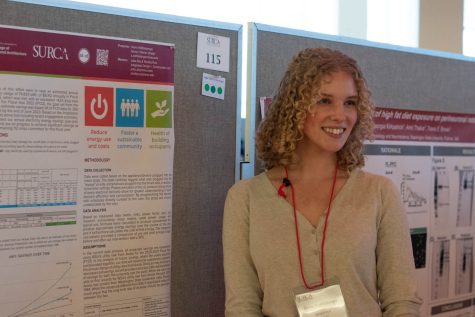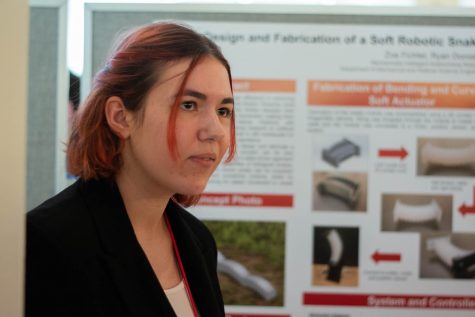Undergraduate students present their research at SURCA 2023
Research ranges from reducing energy use to improvement of policing
SURCA allows undergraduate students to present their research publicly and receive awards.
March 30, 2023
The Showcase for Undergraduate Research and Creative Activities is an annual event where over 100 undergraduate students present their research publicly. The event is hosted by the Office of Undergraduate Research, part of the WSU Division of Academic Engagement and Student Achievement.
Policing Through the Optimization of Empathy

Senior psychology major, Olivia Sciumbato, shares her research project in the CUB senior ballroom Monday, March 27.
Senior psychology and criminal justice major Olivia Sciumbato presented her research on policing through optimizing empathy at SUCRA 2023.
She studied how policing can be improved by optimizing empathy and focused on empathy and the factors that go into an empathetic interaction. Her findings can then be used to train and teach police officers to communicate better with civilians.
Sciumbato said her research aims to improve policing and reduce the use of force and arrests, along with more calm and peaceful resolutions. She decided to research this topic because she is interested in how policing can be improved.
“[Policing] is a huge thing in society currently, and it is a big topic,” she said. “I just wanted to see how it could be improved. Working through the lab and analyzing body cam footage, I wanted to see empathy’s impact on that.”
Sciumbato started in the body cam footage lab a year ago and had been working on her thesis for the Honors College. Her research is ongoing, but she said there are limitations to her study, such as body cam footage.
“You can see the facial expressions and body language of the person of interest, but you cannot see the body language and the facial expressions of the police officer during the interaction,” she said. “That would be something I would want to look at and how that impacts overall empathy.”
She found that tone, pace and language are crucial in an empathetic response but depend on the situational context of the interaction.
“Tone, pace and language are all critical for an empathetic response to be perceived well by a person of interest or just anyone watching the interaction, and that empathy comes in many different ways,” she said. “Everyone has a different way of showing empathy, and it is hugely important that people can understand these different factors and how they come across.”
Sciumbato said researchers could continue their research by looking into other factors, like the gender of the police officer or person of interest, body language, and facial expressions of the police officers during an interaction.
“Empathy is a crucial component in policing and has the potential to help officers create positive relationships with community members and enhance communication and officer well-being as a whole,” she said. “That is what we need to focus on, how we can train officers to be more empathetic as it protects community members from burnout and compassion fatigue.”
Reducing Energy Use + Smart Strips

Senior Interior design major Sierra Rothlisberger shares her research project in the CUB senior ballroom Monday, March 27.
Sierra Rothlisberger, a senior in the Interior Design Program at the School of Design and Construction, is researching energy use and Smart Power Strips as part of the Tenant Engagement Campaign at WSU.
Rothlisberger said Smart Power Strips use automatic scheduling to shut off electronic devices in sleep/standby mode.
She started on the installation team for the Smart Strips and is now the leader of the analysis for the team. Rothlisberger said she aims to implement Smart Power Strips across the WSU campus to increase energy efficiency awareness and reduce overall energy usage and costs across campus.
Rothlisberger said her project is essential because it can apply to a person’s home, not just to WSU buildings.
“We are looking at these electronics plugged into smart power strips that use energy throughout the night, not just during work hours,” she said. “Your electronics at home use energy overnight, and although it might seem like a small amount of cost now, it adds up very quickly in your house.”
The methodology had two parts: the installation process and the analysis. During the installation process, researchers went into offices and installed Smart Strips. She said the researchers also interacted with the people there and taught them how to be energy efficient.
“During the installation process, we keep a little meter on us,” she said. “While we plug in each device, it reads the wattage and the amps used by that device, and we do a couple of different readings and average those out.”
After the data is collected, researchers put their findings into an Excel sheet with a projection formula. She said the procedure determines the amount of savings (y) if x number of strips are installed.
Results showed that they could save $13,000 a year by installing about 190 strips. However, Rothlisberger said her study was limited because it was conducted on campus, where building metering is spread across different departments.
“We are figuring out how to utilize communication between departments better and then also figuring out methods on utility rates and how those change over time,” she said. “That will be some next steps for us.”
The next step in the project is working on a utility rate comparison for their data overhaul. The process will change their Excel spreadsheet and give researchers a better estimate of what they could save.
Design and Fabrication of a Soft Robotic Snake for Locomotion on Various Terrains

Junior mechanical engineering major, Zoe Fichtel, shares her research project in the CUB senior ballroom Monday, March 27.
Zoe Fichtel, a junior mechanical engineering major at the Voiland College of Architecture and Engineering, is researching how to add vertical motion to a soft robotic snake.
Fichtel said the robotic snake is a chain of modules connected to form a full snake. Each module is made of tension cables that will allow the snake to move depending on the direction you pull on.
She said that the robotic snake is intended for search and rescue missions, situations deemed too dangerous for humans, or general exploration.
“Say you were trapped under a bunch of rubble; it could go through the wreckage in the existing spaces rather than moving this and essentially collapsing the Jenga tower on the people trapped,” Fichtel said. “It can tell you what specific pieces to move and in what order to get to that trap person.”
The project aims to add vertical motion to the robotic snake to allow it to move over different terrains. She said this feature could increase the snake’s success rate in search and rescue missions.
Fichtel’s project differed from traditional research because it was more trial and error. She said she went through different theories on creating vertical motion and developed a curve module.
Fichtel said she finished the last part of creating a working module and is working on connecting the modules to make a full robotic snake. From there, she will further test and develop the snake.
The future goal of the project is to add more modules and connect them to form a full snake. Researchers will also test the snake in different types of terrain and create a 3D-printed snakeskin to go over the top of the snake. The snakeskin will help increase mobility, she said.
Understanding the Efficiency of Projectile Technology: Comparing the Atlatl and the Bow

Junior anthropology major, Sam Neuzig, shares his research project in the CUB senior ballroom Monday, March 27.
Junior anthropology major, Sam Neunzig, presented his research on the shift from the atlatl, a tool used to propel a spear or dart, compared to the bow and arrow at SUCRA 2023.
“I am focused on the measurable distance penetration within the ballistic gel and the velocity between atlatl darts and arrows tested with obsidian and steel point the darts,” Neunzig said.
Neunzig said his research aimed to show why groups worldwide adopted the bow and arrow and if people could measure a metric in which the bow and arrow was a better piece of equipment.
The project started at the beginning of the school year and consisted of grading arrows and other equipment for the test. Neunzig said his research was a solo project, but he had mentorship and advice from Anthropology assistant professor Rachel Horowitz and a WSU Ph.D. student.
Neunzig said his project is important because it shows the reliability of the bow and arrow and why groups adopted it worldwide. His research also demonstrated the actual projectile point type they use.
“This shows that the projectile points used for arrows can be used in atlatl darts,” he said. “That is very good for identifying in the field if you’re an archaeologist.”
Neunzig said he conducted primary research at museums like the Ashmolean Museum in England. He conducted background research at libraries and recreated his findings at home and school.
Outdoor testing of the ballistic gel was done using a ballistic chronometer or an instrument used for accurately measuring time. Testing was done between the Palouse and Pullman, he said.
Neunzig found that ballistic gel is easily damaged and increases the chance of an arrow going through a second time. Additionally, he said ballistic gel was a better measurement metric than the ballistic chronometer.
Neunzig said the bow was more reliable than the atlatl, which was highly variable.
“The biggest result we found was that the bow had a reliable velocity and penetration distance, making it a perfect piece of equipment to use, whereas [blank] was extremely variable with the atlatl,” he said. “The atlatl was very affected by the material type of the point, so the obsidian darts could penetrate very easily, very far and move very quickly. But our ultimate determination is that the bow and arrows are more reliable equipment.”
For future research, Neunzig recommended that researchers reconstitute the ballistic gel.










